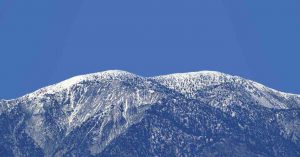 What’s a California winter with no snow-covered peaks? How will we even know it’s December?
What’s a California winter with no snow-covered peaks? How will we even know it’s December?
What’s Next For:
Revolutions?
Syria?
Mexico?
Japan?
The United States?
Earthquake Safety?
Climate Action?
California Water?
Climate Science?
Solar Energy?
California Fruit Farming?
Technology Investing?
Nanoscience?
Digital Storage?
Artificial Intelligence?
Cyber-Threats?
Social Media?
Space Exploration?
Science Museums?
The Sagehen?
Biodiversity?
The Blind?
Big Data?
Mental Illness?
Health Care Apps?
Maternity Care?
Etiquette?
Ballroom Dance?
Thrill Seekers?
Outdoor Recreation?
Funerals?
Writers?
Movies?
Manga?
Alt Rock?
Women in Mathematics?
By the end of this century, Mt. Baldy and the other mountains in the San Gabriel and San Bernardino ranges will be snowless, says Char Miller, director and W.M. Keck Professor of Environmental Analysis and History. For Miller, it’s not just about losing the great views but the natural water storage that keeps the valleys hydrated.
“The natural system we have is shifting,” says Miller. “Water won’t be stored in glaciers or snow banks to slowly release in the spring, which means when the rain falls, it’s going to be moving. We’re not going to be able to manage water with dams.”
Miller says there is more than one culprit. Climate change is at the top of the list, but so are slow-moving plans to capture fast-moving water (which can travel up to 60 miles an hour on its way to the Pacific) and antiquated water rights that affect how we manage water.
The worst drought in recorded California history has prompted a number of ideas to capture, preserve and distribute water, including projects like desalination plants in San Diego and a proposal for two 35-mile-long tunnels that will carry water from the Sacramento River to the San Francisco Bay area, the San Joaquin Valley and Southern California.
“Orange County, which is way ahead of L.A. County and others, has one of the world’s largest, if not the largest, treatment plant, where they’re grabbing every drop of black water (sewage) and cleaning it up to a level that you can drink it,” says Miller. “Because no one wants to talk about toilet to tap, they’re pumping it into their aquifers and out on the other side as groundwater, which is kind of a fig leaf.”
Some solutions have been around for years, including aquifers, sponge-like areas where the water run-off is stored naturally in the ground. Miller points to Pomona College as an example, where bioswales and permeable landscaping direct water to an aquifer under campus.
“Go look at a picture of the Greek Theatre after the 1938 flood,” he says. “There are students paddling boats there. It is a sink, literally a sink. Nature did that. Reservoirs can trap water, but it also evaporates. If we’re smart, we would utilize these natural aquifers.”
In L.A. County, two miles from the College, the Chino Water Conservation District has been doing just that since the 1940s, says Miller. Initially confined by law to work within the boundaries of San Bernardino County, the district is starting to collaborate across county lines.
“I think there’s going be a shift in terms of how we think about collaboration, how we ignore existing political boundaries, because nature ignores them,” says Miller. “What we also have to do is to rethink not just water as a consumable thing, but how we want to live in a landscape that burns, that floods, and in which the sea level is rising. There are lots of things that we could do right now, and must, if we’d like future generations to look back and say, ‘You know, they actually tried. They may not have gotten it right all the time, but they tried.’”
